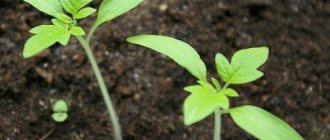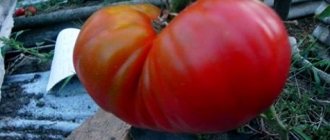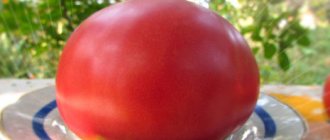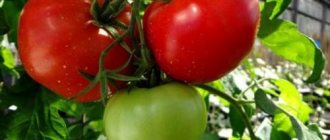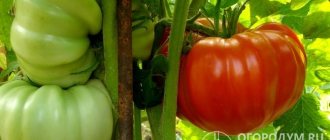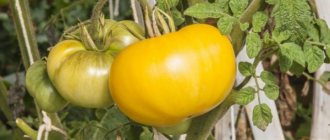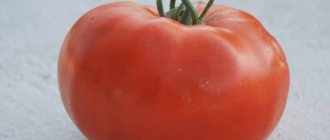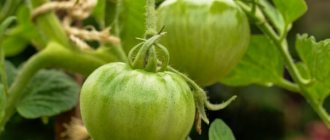Planting tomatoes with seeds in open ground
If you didn’t have time to sow seedlings, you don’t have to worry, since growing tomatoes from seeds in open ground is quite possible.
Advantages and disadvantages of the seed growing method
Sowing seeds in open ground or a greenhouse has undoubted advantages:
- The plant develops with stronger immunity;
- The crop is hardened in the garden bed;
- The root system becomes more powerful, because the plant has no space restrictions;
- The tomato does not experience replanting stress;
- Plants planted using this method do not have black stems.
But there are also disadvantages. For example, low germination, lack of constant monitoring of young shoots, and the possibility of crop loss when using defective seed material or sudden frosts.
Preparing the beds
For tomatoes, it is recommended to choose an area protected from the wind, unshaded most of the day. The soil should be neutral or slightly acidic (pH 6-7). Good tomato productivity was observed on sandy loam and mixed soils.
Tomatoes that are grown in compliance with the rules of crop rotation are less likely to get sick and produce a more abundant harvest. They are planted in beds after carrots, cucumbers, or onions. You cannot plant tomatoes after potatoes, eggplants and all types of peppers.
The bed for growing tomatoes is prepared in the fall. Carefully remove plant debris and foliage, dig up the area to a depth of 30 cm.
When digging, add organic matter at the rate of 5 kg per square meter. You can use humus, compost, peat infusion, or bird droppings. If organic matter was added last year, it is preferable to use mineral fertilizers: 30 g. potassium salt and 60 gr. superphosphate per square meter.
In autumn, winter green manure can be sown on the prepared area. Two weeks before planting the seedlings, they are mowed and embedded in the soil. Green manure plants left on the surface will serve to mulch the soil.
Planting tomatoes with seeds
The timing of sowing seeds coincides with planting seedlings in open ground. In the Northern regions, where late frosts are possible, planting begins in mid-May.
Seeds for sowing can be used either germinated or dry. To germinate, they are heated at a temperature of 25-27 degrees Celsius for 2-3 hours, or soaked in warm water for a day, and then left for 2 days to hatch.
Seed material is sown with a small reserve. If you are going to leave one plant per hole, then plant 3-4 seeds, and if two, then 4-6. The distance between the seeds should be at least 3 cm so that later thinning can be carried out without problems. Plant the seeds to a depth of 2-3 cm, sprinkling the top with a small layer of 1-2 cm of soil. After sowing, the holes are watered with a small amount of warm water.
At night, it is recommended to cover the crops with agrospan, lutrasil or agril. You can use a film cover, but the film should not be allowed to touch the young shoots, so it is pulled over supports. During the day, at temperatures above 18 degrees Celsius, the sides of the shelter are opened for ventilation.
Proper planting of seedlings and timing
Preparing for landing
The plot of land for tomatoes should be well warmed up and ventilated from all sides. It is not recommended to plant tomatoes in one area for several years in a row. Good predecessors of tomatoes are beets, corn, and carrots.
Optimal timing for planting seedlings in open ground:
- when the top layer of the earth warms up to a temperature of +14 °C and the threat of soil frosts passes;
- in central Russia, the optimal landing time is from the end of April to the end of May;
- in harsh climates, the deadlines shift to two to three weeks later.
Stages of planting seedlings:
- remove the lower leaves and deepen the seedling by 5 cm when planting in a hole;
- It is recommended to immediately dig in pegs to support the bush;
- planting in the ground should be carried out in the evening;
- After planting, water the seedlings with roots.
The planting pattern depends on the variety that is grown.
Square nest planting
For low-growing tomatoes that are grown in three to four shoots, use a square-cluster planting. 2-3 bushes are planted in a square measuring 80*80 cm at a distance of half a meter from each other. The distance between each square is 80cm. With this planting scheme, wide bushes are convenient to water, weed and fertilize.
Tape-nest planting
Convenient for tall varieties that are grown with one or two stems. A trench with a depth and width of 30 cm is dug on the site. Seedlings are planted on both sides of the trench at a distance of 40 cm. The distance between each trench is up to 1.3 m. Tall bushes without side shoots will have enough sun and air between the rows. In addition, this method of cultivation saves space on the site.
Tape planting
If you have a small area, the tape method will be the most optimal. It will save space and your time when watering in the future. To plant using the strip method, dig a not very deep trench (about 30 cm) and form holes at a distance of 40 cm from each other. About 80 cm is left between the trenches.
general information
This variety was bred at the beginning of the millennium, namely in 2002, by Russian breeders. Two years later it was entered into the state register, since then tomatoes have been actively grown, and they have won the hearts of absolutely all summer residents with their performance. If we talk about growing regions, then the warm regions of the south are ideal for cultivation in open ground, but the rest can grow this variety in greenhouses - film or polycarbonate. The peculiarity of the “Honey Giant” is that it is sensitive to temperature changes. But, of course, it has many more advantages, more on them later.
Landing
It is better to sow seeds in the second half of March if you plan to grow them in a greenhouse. For transplanting into open ground, seedlings are sown in April.
After two months, the seedlings can be transplanted.
Proper care will allow you to grow maximum yield
Sowing
Seeds are disinfected with a manganese solution and germinated in a wet cloth. The soil mixture for sowing is prepared from turf soil, peat and a complex of mineral fertilizers.
The seeds are laid out at a distance of 2 cm and deepened into the ground by 0.5-1 cm. The sowing is generously moistened with a spray bottle. The box is closed (with plastic film or glass) and the temperature is set at 24-26°C for 5-6 days.
Seedling
After the shoots appear, the box is opened and moved to the windowsill. The temperature is kept at 16°C for a week. The seedlings are watered every 10 days and the soil is sprinkled with ash powder.
Tatyana Orlova (Vasilidchenko) (candidate of agricultural sciences):
Watering the seedlings is carried out as the soil dries. Ash powder is used at the first symptoms of a disease called “black leg” - rhizoctonia.
After 2 true leaves appear, the plants are planted in separate pots, while fertilizing the soil. Two weeks before transplanting into the garden, the tomatoes begin to harden - they are systematically taken outside or the windows are opened. The time spent in such conditions must be gradually increased so that adaptation gradually occurs.
Transfer
The seedlings are transplanted into a garden bed in loose, fertilized and disinfected soil with manganese. Pre-install a trellis or garden net for tying. The distance between the holes is 50 cm. It is advisable to put compost, ground eggshells, ash, and mineral fertilizers in the planting holes.
When planting, plants should be watered abundantly, using warm, settled water.
We carefully monitor the condition of the branches and tomatoes
Honey giant bushes form 1-2 stems. To do this, remove the side shoots, pinch out the growing point, and cut off several lower leaves once a week. Not only the stems of the plant, but also heavy brushes are subject to garter.
Tatyana Orlova (Vasilidchenko) (candidate of agricultural sciences):
Pinching of the growth point (topping) is carried out either when the tomato plants reach the roof of the greenhouse, or (in cold regions) to speed up the growth and ripening of the fruit.
According to the description, if the grapevine is broken, the tomatoes do not ripen, and if the shoots fall down, the fruits touch the ground and may rot.
Watering
For irrigation, use warm, settled water, and from time to time a solution of manganese or ash.
Water the plants strictly at the root or use the drip method. The procedure is carried out in the morning or evening every 10 days. In hot summers, more often - every week.
Feeding
Fertilizers are applied once every two weeks, alternating organic matter and mineral complexes.
Organic fertilizers are needed for soil fertility, and minerals nourish and strengthen the root system.
If possible, fertilizing is combined with watering using liquid and water-soluble fertilizers. A deficiency of one or another mineral can be quickly compensated for by foliar feeding on the leaves.
Other care measures
To maintain humidity levels, the greenhouse is regularly ventilated. After watering, the soil is loosened and the tomatoes are hilled. As weeds appear, the beds are weeded. Instead of loosening and weeding, you can do mulching. Mulch not only saves the gardener’s effort, but also reduces moisture evaporation.
Rules of agricultural technology
The description of the Azure and Early Giant tomato varieties confirms that tomatoes require a lot of attention from gardeners and some care.
To protect tomatoes from diseases, it is necessary to observe crop rotation and not plant tomatoes in the same place for several years in a row.
Seed treatment
Before planting, seeds purchased from a specialized store or obtained from the harvest are treated with a weak solution of potassium permanganate. They are then washed in clean water and placed in a special solution that stimulates growth. After 1 day of exposure to the drug, the seeds are placed in a cool room for hardening.
This variety is grown by planting seedlings. To plant seeds, obtain light soil consisting of humus and garden soil. River sand and wood ash, calcined in the oven, are also added to this mixture.
Planting seeds
Plant the seeds at the end of winter in containers with soil. The seeds are buried in small grooves and sprinkled with peat on top. Then the container is watered with warm, settled water. The air temperature in the room should be about +23 - 25 degrees. After the first shoots appear, the containers are taken to a room with a lower temperature, +16 - 20 degrees. There should be no drafts.
They are placed on the sunny side, providing sufficient illumination. If the weather is cloudy for a long time, it is advisable to provide additional lighting with fluorescent lamps
Containers with seeds should be watered carefully, using a spray bottle or a regular strainer. After the formation of the first leaf, the seedlings are picked, transplanted into another container and watered with complex fertilizers
For hardening, seedlings, starting from the end of April, are taken daily to a cooler room or to the air.
After the formation of the first leaf, the seedlings are picked, transplanted into another container and watered with complex fertilizers. For hardening, seedlings, starting from the end of April, are taken out into a cooler room or into the air every day.
Transplanting seedlings into soil
Transplantation into the soil is carried out towards the end of May. Bushes of these varieties are placed in such a way that per 1 sq. m accounted for 3 plants. Fertilizers and wood ash are added to the dug hole, and then the seedling is placed and covered with soil. Bushes with lush green parts but a weak root system will be more difficult to take root and grow slower.
To ensure a longer harvest of such tomatoes, new tomato bushes are replanted 3 weeks after the first planting.
Watering
Water the bushes after the top layer of soil has dried. For irrigation, use only warm water: exposure to cold water has a negative effect on the tomato, slowing down the growth and ability of the tomato to bear fruit. When watering, you should follow this rule: water should be at the roots, not on the leaves. It is considered mandatory to loosen the soil after each watering of the soil.
Formation of bushes
To avoid weakening the plant, remove all non-fruiting stems. It is considered optimal to leave 1 – 2 large stems on one bush. The rest are pinched (cut with a knife at a distance of 2 - 3 cm from the main trunk). Stepchildren are pinched after 4 fruit clusters appear on the bush.
Feeding
Experts in growing tomatoes Azure Giant F1 in reviews advise fertilizing the soil on which tomatoes grow 4 times per season. Both organic and mineral fertilizers should be used
We transplant into the ground and grow the Honey Giant
Before planting, the soil must be checked and prepared. The soil should be loose, so dig it up, simultaneously removing any plant debris and weeds. It is advisable to enrich it with humus and, if necessary, add ash or lime if the soil is loose. After this, the soil is leveled with a rake and approximately how the holes will be located is planned.
Usually, per 1 sq. m. there are about three bushes, since this variety has a large height and spread of clusters. If the soil is too heavy, then peat or sand is used, but here you need to look at the situation. Directly when planting in a hole, which should be 20 cm deep and at a distance of 60x50 cm from each other, it is advisable to add superphosphate, and after planting, water the plant with warm water.
A distinctive feature of this variety is its sensitivity to high temperature changes, so the seedlings are mulched with straw, covering it approximately 10 cm thick.
Supports must be prepared, since the plants are tall.
Experts advise feeding plants after two weeks from the date of transfer with potassium nitrate, and after another two weeks it is advisable to fertilize the soil with a solution of manure and water in a ratio of 1 to 10. Then it is advisable to look at the situation and alternate these feedings and complex fertilizers to achieve the best result.
Once a week in the evening, it is necessary to remove the stepsons (in the end there should be one left in the upper axil) and the old lower leaves, and after each watering, thoroughly loosen the soil. If the seedlings are located in a greenhouse, they are often ventilated.
Hilling is carried out 10 days after planting, and this is done exclusively after watering. Repeated hilling occurs after a couple of weeks. This procedure stimulates active plant growth and improves resistance to various diseases and numerous parasites.
When the stem reaches a height of one and a half meters, pinching is required. At the same stage, tying occurs so that the stem does not break under the weight of the fruit and takes the correct shape.
Features of cultivation and possible difficulties
It is necessary to actively monitor the growth of plants, since due to the fairly high stem, it may require not only a garter, but also reliable support. Considering how heavy the fruits are, of which there will be many on one bush, this is a prerequisite, otherwise the stem may break and the plant will die.
Before positioning the support, disinfect it. When the fruits are already present and begin to actively ripen, remove most of the leaves so that nothing interferes with the tomatoes ripening. Many gardeners water the holes with a manganese solution at this stage to prevent elemental deficiency and improve the plant’s immunity.
Root spraying should not be done, as this method is completely unsuitable for this variety. “Honey Giant” is not considered a particularly picky and difficult variety, so even with average care it produces good yields.
It is advisable to leave only 1-2 stems in the bush.
Diseases and pests
The tomato is quite easy to care for and, in principle, is not susceptible to fungal diseases. The only thing that can cause trouble is poor care
It is important to follow the watering regime, feed the plant, thoroughly loosen the soil and actively fight various weeds
If we talk about parasites, then this variety of tomatoes, like most others, is susceptible to such scourges as thrips, whiteflies, mole crickets, slugs, Colorado potato beetles and melon aphids. If such unpleasant situations happen, then you should use such remedies as “Bison” for thrips and “Confidor” for whiteflies, although folk remedies can also help.
For example, a solution of one spoon of pepper and a bucket of water will help solve the problem with aphids, slugs and mole crickets, or replace the pepper with mustard powder
It is important to use these products for both spraying and watering to achieve the best results.
Keep in mind that all pest control agents accumulate in the fruits, so they are applied before flowering.
https://youtube.com/watch?v=98TpI6ZcaE0
Features of growing Honey tomatoes
Tomatoes of the Honey variety will not cause gardeners unnecessary trouble; you just need to take into account some features of the plant itself and its agricultural technology:
for good yield and high quality fruits of tomatoes of the Honey variety, the place where they are grown should be well lit and warmed by the sun; Honey is an indeterminate plant, therefore, when growing, it requires tying up the stems, removing stepsons, forming a bush depending on the area of cultivation: as a rule, in places where there is enough solar heat and light, the summer is long, the bushes need to be formed into two stems, that is, left one stepson under the lower cluster of fruits, and remove all those located above; in areas where the summer is short, it is preferable to form the bush into one stem, then all the ovaries will have time to grow into full-fledged fruits;
the stems and branches of Honey variety tomatoes are somewhat fragile; heavy tomatoes and bunches must also be tied up to avoid breaking; The recommended scheme for planting Honey variety tomatoes in a garden bed is 3–4 plants per 1 square meter; During the growth period, Honey bushes must be regularly fed with fertilizers containing potassium and phosphorus, strictly observing the dosages and application schedule given in the instructions. For example, you can use potassium monophosphate, which is applied in the form of a solution (7.5–15 g of fertilizer per 10 liters of water per 1 m2 of bed);
When the bush reaches its maximum growth and is fully formed, it is recommended to use complex fertilizers, for example, Kemira Lux. The complex, in addition to the main elements (potassium, phosphorus and nitrogen), also includes iron, copper, boron, molybdenum, manganese, and zinc necessary for plants. To fertilize 1 m2 of bed, 20 g of fertilizer is dissolved in 10 liters of water.
In a greenhouse, such fertilizing is carried out once a season, in open beds - once every half month; For Honey tomatoes, it is important to follow the watering regime: when planting seedlings in the ground - 5 liters per hole, then do not water for a week; during the rooting period of seedlings - 2 times a week, 3 liters of water per bush; during tomato flowering - 5 liters of water per bush once a week; during the formation of ovaries and growth of tomatoes - 2 times a week, no more than 3 liters of water per bush, the soil should not be waterlogged; during the ripening of tomatoes - once a week, 3 liters of water per bush, so that the fruits do not crack.
Watering done in the afternoon is most effective.
Tomatoes of the Honey variety are productive, resistant to diseases, and rarely damaged by insects. They do not require much care from the gardener. To grow them successfully, it is enough to listen to the advice that we tried to collect as much as possible in this article.
Care after disembarkation
For the Honey variety tomato, the recommended planting pattern is: 40x60 cm. What it needs for successful development in a greenhouse:
- Enough light. The greenhouse must be lit all day.
- Stable air temperature: at night not lower than 18 degrees, during the day – not higher than 22-24. In hot weather, you need through ventilation to prevent the plants from overheating. At temperatures below 14 degrees, tomatoes stop growing. If it exceeds 30 degrees, the pollen becomes sterile and flower pollination does not occur.
- Sufficient, but not excessive watering. Before fruiting, plants are watered once a week with such an amount of water that the root layer is completely moistened. With the beginning of fruiting, the amount of watering is doubled. Water the Honey tomato only with heated water. It should not be colder than the air in the greenhouse. Watering should be carried out in such a way as to have time to ventilate the greenhouse well. You cannot leave humid air in it overnight.
- Mulching the soil. Mulch is an invaluable assistant to the gardener. Under it, the soil and plant roots do not overheat, moisture is retained much better than without it. The soil will not have to be loosened, which means that the roots of the tomatoes, located superficially, will not be disturbed. Weeds will not grow in the greenhouse. For mulching Honey variety tomatoes, cut and dried grass, straw, and dry hay are suitable. The mulch layer should be no thinner than 10 cm. It needs to be added from time to time.
- Feeding. Tomato loves food. Foliar feeding for this plant is done only as a last resort - it is not advisable to wet the leaves of tomatoes. Root feeding begins when the seedlings take root. They are made once a decade, using a complex soluble fertilizer with microelements, of which tomatoes especially need boron, magnesium and calcium.
- Formation. The peculiarities of the formation of the Honey variety tomato have already been described above. You can add that the stepsons on plants need to be removed weekly so that the plant spends energy on the growth of fruits, and not vegetative mass. Pruning should not coincide with watering. At the beginning of August, you need to pinch the tops and remove excess inflorescences - they will not have time to produce a full harvest. In regions with warm autumns, this date can be postponed to the end of August. The bush will also need to be lightened: as soon as the fruits in the cluster have completely reached the desired size, all underlying leaves are removed. They do this in several steps.
If you follow all the rules of agricultural technology and carry out preventive treatments against late blight, the harvest of tasty large fruits will please any gardener.
More information about the Honey tomato can be seen in the video:
Ulyana, Vyksa
I’ve been “sick” of tomatoes for a long time. I tried many varieties. Most of all I like large-fruited and tasty ones. I don’t plant “rubber” hybrids. The tomato should be the same as our grandmothers grew it. One of my favorites is the Honey tomato. With good care, it grows 0.5 kg or more. The taste is simply amazing, it lives up to its name. I will never part with this variety.
Julia, Syzran
Among all the nightshades, the tomato is in first place in the garden. My favorite thing is tomato and basil salads. I mainly grow salad varieties of different colors. Of the pinks, I like Honey. One such tomato is enough for a salad for the whole family.
Variety Guide
- The bushes have unlimited growth; in greenhouse conditions they reach a height of 2 meters. In garden beds, bushes grow to a height of up to 1.5 meters.
- The ovaries are formed in clusters; there are 7-8 clusters on one bush. The ripeness point of fruits varies.
- Harvesting begins in July and continues until frost. The last tomatoes are ripened at home.
- The fruits are round, slightly flattened, and when fully ripe they acquire a bright yellow color. There is a green spot somewhere on the stalk.
- The average weight of one tomato is 400 grams. In greenhouses, pomona gifts can reach a weight of up to 1 kg.
- The pulp is dense, often covered with pink veins.
- The taste is sweet, without sourness.
- The skin is thin and durable.
- Tomatoes have good shelf life and are suitable for long-distance transportation and long-term storage.
When to plant seedlings
Be sure to pay attention to the appearance of your seedlings. Plants ready for transplanting:
- at least 25-30 cm in height from the root collars;
- 6-10 true leaves;
- there are the first buds.
When there are a lot of seedlings, I reject all non-standard plants: too small or elongated, damaged.
Spring
If you plan to grow seedlings for open ground, there is no need to soak the seeds for seedlings in late February-early March. These terms are good only for greenhouse plants. And for seedlings in an open garden bed, the seeds are soaked only towards the end of March or beginning of April.
I focus on the timing of the transplant. I plant the seeds approximately 50-60 days before the seedlings are expected to move into the garden.
Summer
I usually plant tomato seedlings in open ground in two stages to get both an early and late harvest:
- In the beginning of May. I definitely protect the plantings with covering material. Before transplanting, I warm up the future bed, covering it with black polyethylene.
- After June 10. By this time, the threat of frost has passed in central Russia - shelter is no longer needed for planting.
But these are still approximate dates. Depending on your region of residence, I recommend that you follow this schedule:
- Middle lane. Planting in open beds is possible from the beginning of May.
- Ural, Siberia, north-west of the country. Not earlier than the end of May or beginning of June.
- Southern regions. From the second half of April.
If you use a covering film, the planting dates can be set a week earlier. The main reference point is the soil temperature. You should not plant tomatoes if the soil has not warmed up to at least 8-10 C. The best soil temperature for tomatoes is 12 C. It should be not only on the surface, but also throughout the entire depth of the hole (approximately the bayonet of a shovel). Frost is the enemy for heat-loving tomatoes. If the soil temperature drops to 0-2 C, the plantings may die.
According to the lunar calendar
Important periods in 2021 for gardeners who follow the lunar calendar:
- Favorable dates for planting seedlings: March 7-10, 15, 16, April 6, 7, 11, 12, 17, 18.
- Favorable dates for planting in the garden plot: May 2, 3, 8, 9, 15-18, June 5-6, 13-15.
But on the full moon and new moon you should refuse the transplant: June 3-4, 17.
Hardening off seedlings before planting in open ground
I always harden off my seedlings - I start 2 weeks before transporting them to the garden. The procedure itself is simple:
- Take the cups or boxes with plants out onto the balcony. If you are planting seedlings at the dacha - in a heated greenhouse. Make sure that the room temperature does not fall below 8-10 C.
- On the first day, half an hour of hardening is enough for young tomatoes.
- In the following days, gradually increase the time the seedlings stay in the new conditions.
- By the end of the 2-week hardening, they should already spend a full day on the balcony.
In order not to harm young plants, prepare the hardening site: protect it from strong drafts and direct sunlight. To do this, open the balcony frame only to the microventilator, and place the tomatoes themselves in partial shade. You can use newspapers, not transparent curtains.
The day before transplanting, I always carry out pest control. This is the best time - by the time of harvest, all substances harmful to the human body have already been completely removed from the plant. I prefer to use “Antikhrushch”: it protects seedlings from several pests at once - whiteflies, wireworms, beetles, and mole crickets. For each glass of tomato – 30-50 ml of a weak concentration solution.
Description of the variety
According to the description of the variety, there are not so many leaves on the branches of the Pink Giant tomato, but they are large. Fruit ovary occurs in clusters consisting of several inflorescences. Sometimes, as summer residents write in reviews, 6 of them are formed on each brush.
The fruits are round, noticeably flattened. Most tomatoes weigh about 400 grams, but each bush ripens several tomatoes weighing from 1 to 1.2 kg. There are often cases where only one giant tomato weighing up to 2.2 kg grows from one inflorescence. Such Pink or Yellow giants always have an irregular shape, as can be seen in the photo.
Reviews
Most gardeners grow Honey Giant from seeds produced by the Aelita agricultural company. In general, the characteristics of the fruits correspond to those stated: they grow sunny yellow, large and beautifully rounded. Tomatoes are usually sweet and aromatic, but in a bad summer they can taste bland.
It has been noticed that in open ground, when located closer to the north, the fruits grow medium in size (from 150 to 250 g). Therefore, most recommend planting this variety in a greenhouse.
The crop has excellent shelf life and is transported without problems - you can grow it not only for yourself, but also for sale.
Description of the variety
The variety can be called relatively new, since it was bred by Russian breeders in 2001 and registered in the State Register in 2003, but during its existence it managed to win the hearts of many gardeners.
The tomato gained its fame thanks to its commercial qualities and for many years has topped the lists of the largest and most remarkable varieties. This variety is standard and indeterminate, since in terms of growth it can reach 150 cm in height.
Distinctive features
The very name of the variety already speaks volumes. Its huge size in relation to other tomatoes arouses such interest and recognition among both amateur gardeners and real collectors of the most attractive varieties.
According to statistics, with proper and constant care, the vegetable can easily grow from 600 grams to 1 kilogram. However, this applies more to real professionals, and in most cases, with average care, the result is a fetus of 350-400 g.
No less attractive is the beautiful bright orange, sometimes yellow color that the tomato turns into when ripe. This coloring brings not only aesthetic pleasure, because yellow varieties of tomatoes have a more enriched vitamin and mineral composition, while yellow tomatoes do not cause allergies. They contribute to the healing and rejuvenation of the body.
Fruit characteristics and yield
If we talk about the fruits, they are large in size and flattened in shape. The skin is thin, bright yellow or orange, and when cut, the tomato will even have pinkish tints. With the right approach, they can be easily stored for a long time and tolerate transportation well, maintaining their aesthetic and taste qualities.
The taste is juicy and sweet, moderately containing liquid and pulp, while being resistant to cracking and having an excellent appearance after ripening. According to official data and evidence from gardeners, they contain up to 6% dry matter. Average number of seeds.
The productivity is quite high. One bush can produce from 5 to 7 kg of tomatoes. They surpass many varieties in terms of productivity and bring amateurs and professionals up to 15 kg of fruit per 1 sq. m.
general characteristics
The Honey Giant tomato variety belongs to the indeterminate type. The bushes reach a height of 120 to 200 cm. Fruiting is mid-early, beginning 100-110 days after sowing.
A tall bush produces 6-7 fruit clusters, each of which contains 3 to 6 tomatoes (to obtain larger ovaries, they are normalized).
Fruit
Tomatoes of this variety have a round, slightly flattened shape. Fruit weight is from 350 to 600 g. The skin color is yellow-orange, the flesh is pinkish. The taste is very sweet, with a light fruity aroma.
The fruits are consumed fresh - in salads, slices and as a snack. They are not suitable for whole canning because they are too large. However, they can be used for mixed vegetables or winter salads.
Productivity
The variety is distinguished by high yield. With proper care, 5-7 kg are collected from one bush. To improve performance, frequent feeding and the formation of bushes with one stem are recommended.
Disease resistance
The honey giant will show resistance to diseases if the necessary prevention is performed. Among the potential insect pests, it is threatened by aphids, whiteflies, slugs and thrips.
This variety tolerates temporary changes in weather calmly, but in rainy and cold summers the taste of the fruit can change for the worse.
